Made By:
Road Signature (Yat Ming)
Scale:
1/24
MSRP:
US$69.99
| Overview: | |
|---|---|
| Packaging (Design): | 10/10 |
| Packaging (Durability): | 10/10 |
| Casting (Body): | 10/10 |
| Casting (Interior): | 10/10 |
| Casting (Chassis): | 9/10 |
| Casting (Engine): | 9/10 |
| Paint (Exterior): | 9/10 |
| Paint (Interior): | 9/10 |
| Paint (Trim/Graphics): | 10/10 |
| Overall Panel Fit: | 9/10 |
| Total Score: | 9.5/10 |

Other Book Models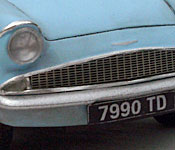
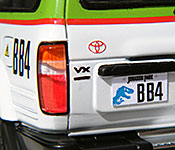
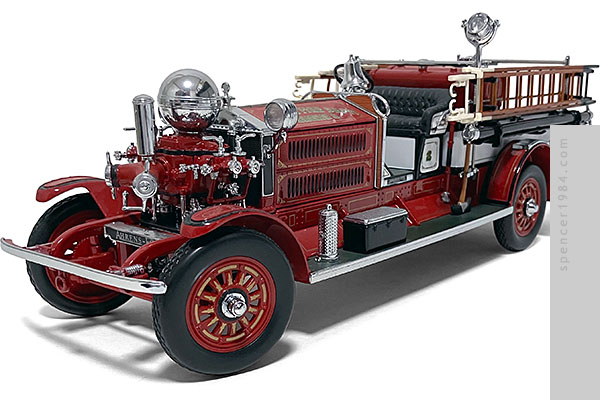
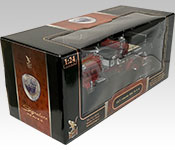
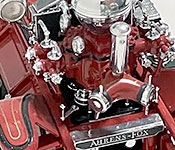

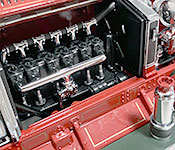
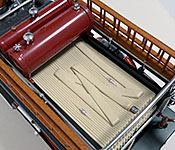
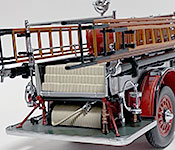
Background
While best known for his series of Dirk Pitt novels, Clive Cussler wrote several other series including the Isaac Bell Adventures (set in the early 20th century and featuring the character as an investigator for the Van Dorn Detective Agency) and the Fargo Adventures (centered around professional treasure hunters and married couple Sam and Remi Fargo). These two had a crossover of sorts in The Gray Ghost, itself a joint venture having been co-written by Robin Burcell. While the novel primarily focuses on the search for the titular Rolls-Royce, an Ahrens-Fox played a crucial role in the story and appeared twice on the cover: once as part of the main cover art depicting the truck's Big Damn Hero moment in the story, and again on the back cover in a photograph of Cussler with his own Ahrens-Fox.
Packaging
Yat Ming used the same large boxes for their fire truck series as they did for their Presidential limousines. The inner trays are still flocked to look like suede, but are now black to contrast with the red fire trucks. The accessories are in a two-part plastic tray snapped into the back wall of the inner tray, centered above the truck. To the left of this is the gold collector coin, and the Certificate of Authenticity is clipped into the cardboard tray making up one inner end flap. The truck itself is held in place with two large plastic clips wrapped around the running boards and screwed to a plastic base through the bottom of the fuzzy tray. A soft foam pad is fit between the boards and clips to prevent scratching. Finally, a small plastic tool is clipped in a tray under the rear of the truck. The tool has a flat angled head, and is used to ease operation of some features like the opening hood.
Casting/Paint
Owing to the nature of the vintage fire pumper, this is a massively complex model with myriad overlapping parts and intricate subassemblies that mix diecast metal and plastic. Most of it is finished in either dark red or bright chrome, with a smattering of other colors like dark gray for the seat and dark green for the floor and running boards. As an example of how complex the color breakdown can get, the single-piece front bumper is cast in chrome with red paint applied to the top and bottom of the bar and the brackets around the (still chrome) springs and arms. The red perfectly matches the frame/body/pump/hood/etc. paint, and said paint has a smooth semigloss finish that perfectly captures the look of well cared-for vintage paint. Gold pinstriping is applied across the whole of the truck, and black is used to accent the edges of the fenders and the hood louvers. "Nashua Fire Dept./Engine 2" is written in gold with a green drop shadow on each top panel of the hood. Coverage and registration are excellent, even on tricky parts like the louvers, and the pinstriping is nicely centered on each panel.
The pump is a work of art unto itself - every lever, valve, cap, and bolt head is captured beautifully. It's topped with a brilliantly executed reproduction of the famous spherical air chamber, and its base is the forward crossmember bearing the "Ahrens-Fox" name in silver over black. Behind the pump is the chrome radiator complete with the appropriate hoses, lines, and cap with gauge. The stalk-mounted headlights on either side of the chrome shell have separate clear lenses.
Moving back, the four-piece hood has a central piano hinge and simpler two-piece hinges connecting the upper and lower panels. It opens realistically to reveal an excellent replica of the massive 998 cubic inch T-head inline six engine. Unlike some of the limos, this is a complete engine from the distinctive heads down to the fully detailed oil pan, and from the four-bladed fan back to the toothed flywheel.
The underside isn't quite as "display ready" as the rest of the truck, thanks to the visible screw heads and axle supports, but even here Yat Ming went as far as to include the proper drives, suspension components, even the distinct top loader rear axle. The wheels are excellent, faithfully capturing the look of the 12-spoke wooden wheels and sporting vinyl diamond-tread balloon tires and chrome hub caps.
The full-length running boards have the aforementioned green treads accented by chrome strips along the edges. The left board has a box and strainer mounted between the fenders, and the right board two more boxes and a removable fire extinguisher. The rear platform has four mounted nozzles and the clip for the hose reel crank handle. The reel itself has a softgoods hose and a chrome nozzle, but does not actually unwind. A nice attention to detail, each corner of the rear deck has a tiny plate with "Ahrens-Fox" cast and painted despite the letters being less than 1mm tall.
The high seat has outstanding tuft and button detailing, with a slightly lighter-than-black finish that suggests vintage material. Chrome grab handles are on both sides of the seat, and the pedestal is painted white with intricate pinstriping and the number "2" in gold and green. Two pedals and a switch are mounted to the floor and two levers are just off the right side. The firewall has subtle woodgrain effect with all the appropriate gauges and controls, including a finely detailed steering column topped by a five-spoke wheel with a black rim. Centered at the top of the dash is a chrome bell, cast to appear like it could actually work with a hollow body and detailed clapper. A tiny name plate is on either side of the floor, just above the frame rails.
Behind the seat is the hose platform, with several lengths of hose cast in place and painted beige. A chrome rack surrounds the top of the platform and serves as a mount for the spotlight and removable ladders. The ladders are painted in a yellow woodgrain to suggest a high gloss varnish, with the feet painted black and the heads (and hooks) painted off-white. Immediately behind the forward crossbar are a pair of tanks, complete with chrome caps and valves. A vinyl hose with chrome connectors is in a saddle just under the ladder on each side, an axe is clipped to the rack with its head resting on the running board just inside the ladder on each side, and a lantern with a red globe is at the rear of the rack under the ladder on each side.
Features/Accessories
The front wheels steer and are tied to the steering wheel, both sides of the hood can open (but not at the same time without looking awkward), the upper spotlight can be moved on a swivel but is weighted so it only points forward (just above or below true horizontal), and the rear lanterns are on swivels so they can be moved closer to or further from the fenders. Both ladders and the extinguisher can be removed, and the ladders can be extended to an impressive length. The axes are not designed to be removed, but are only pegged into the running boards so with a touch of excessive force they do come off. Finally, a 24K gold plated collectors' coin is packed in the box.
Accuracy
This is based on a specific fire pumper that first served the Nashua, New Hampshire fire department before being sold to Benny Snyder of the Benny Snyder Orchestra. The truck was later acquired by Jack Boyd Smith Jr., and received a full restoration to become part of his collection. This diecast is modeled after what the truck looks like today, down to the accessories. It matches all the reference photos very well, maybe being a half-shade darker than the 1:1 but otherwise an excellent match. Scaling is very close, but looks to be a hair over at 1/23.
Overall
The Ahrens-Fox was known as the "Rolls-Royce of fire engines," and even in scale it has a presence. There are relatively few pop culture uses of the truck, but even so it's worth having in the collection simply because of what a great job Yat Ming did here.
Send me an e-mail with your thoughts!